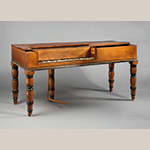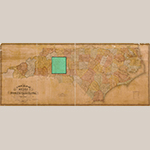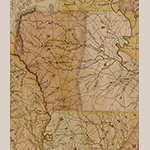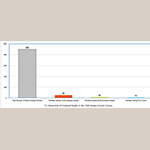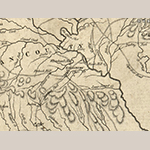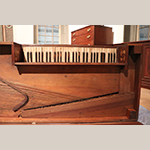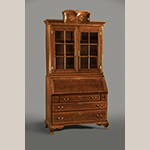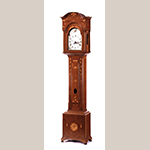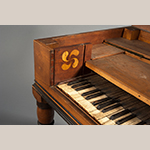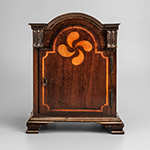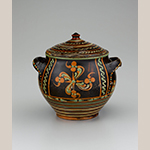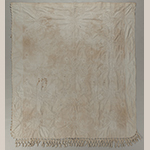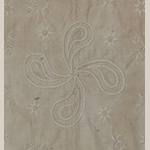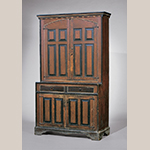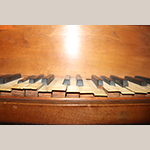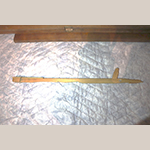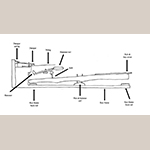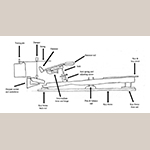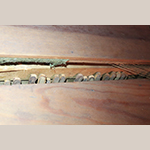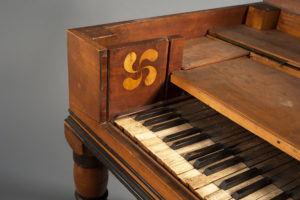
In rural antebellum America, a curious convergence of piano production and exuberant creativity inspired craftspeople with little to no formal training to create their own keyboard instruments. Amateur-made instruments deviate from professional norms, yet often display aesthetic influences from conventional piano forms and showcase creative solutions to the construction of intricate mechanisms that comprised some of the most complex technology extant in the early nineteenth century. Once dismissed by most experts for their odd qualities, surviving instruments and archival materials document a numerically small tradition of amateurism within American keyboard instrument craft. This article explores the intersection of cabinetmaking traditions, female accomplishment, and the musical environment of rural North Carolina as reflected in the production of an amateur-made piano crafted by David Prichard of Iredell County, North Carolina.
While piano making falls under the broad category of the woodworking trades, the skills required for the production of keyboard instruments are more exacting than in those of mainstream woodworking trades, such as cabinetmaking, joinery, and carpentry. With hundreds of individual parts and tight tolerances, the production of a piano did not easily lend itself to attempts by untrained makers. While the building of these instruments certainly required skills that overlapped with the trade of cabinetmaking, the task of creating an object that not only possessed a pleasing appearance, but could also produce music, necessitated expertise that surpassed what was generally required of other woodworking trades.[1] These qualitative challenges often resulted in instruments with technical idiosyncrasies including overbuilding and other creative solutions that altered sound quality.
The capabilities of what a piano can and should be able to do were judged by auditory standards established by local performances, whether by accomplished amateurs, internationally trained professional musicians, or itinerant teachers. Craftsmen of the American Backcountry were inspired by standard keyboard instruments, but competing in markets far from urban centers freed their work from conventional comparisons. Pianos, with their strong tradition of amateur interaction in performance, proved to be ideal fodder for stretching the limits of amateurism in both music and craft, reflecting nineteenth-century American ideals of individualism and self-reliance.
— ♦♦◊♦♦ —
In February of 1840, twenty-one-year-old Sophia Correll of Rowan County, North Carolina, the earliest known owner of the piano made by David Prichard, married farmer David Linn.[2] Hers was a happy union to a close friend of her eldest brother, Levi. The couple had grown up together in the southeastern Rowan County town of China Grove, ten miles below the bustling town of Salisbury.[3] As a young bride transitioning into her new role as the spouse of a farmer, the new Mrs. Linn left behind elements of her girlhood—stepping away from practice at her piano keyboard as other responsibilities took precedence.
A gift from her father during her teenaged years, Sophia Correll’s keyboard instrument (Figure 1) was a highly coveted sign of accomplishment and entertainment brought to life by Sophia Correll.[4] Her control of volume and sound, a principal feature of the piano, mirrored her power to control her surroundings and express herself through music. However, her piano was significant not only because it fostered amateur musicianship and a degree of independence from antebellum society’s strictures about propriety, but also because it was an object of unique and ingenious craftsmanship that embodied American self-sufficiency.
Square in form, the instrument represented the genteel amateurism demanded of young ladies in antebellum America and reflected the particular design of keyboard instruments favored by consumers in the United States at the time. The presence of such an instrument, likely housed in the parlor, was no doubt a public statement of the Correll family’s status and aspirations; the square piano expressed a cultivated knowledge of social graces, a familiarity with Western art music, and sufficient financial security to acquire, maintain, and properly use such an object. For Sophia Correll, it represented hours of dedicated practice and the freedom to shape her own soundscape at a time where opportunities to hear music were limited to those who knew how to play, or those who enjoyed close proximity to someone with that knowledge. The benefits of ownership extended beyond the parlor as a long-term investment, that shaped the reputation of the Correll daughters within Rowan County society.
Sophia Correll was very fortunate to receive a square piano, despite her status as a white woman who enjoyed a comfortable upbringing, comparatively. A piano was not a common sight in Piedmont North Carolina houses during the second quarter of the nineteenth century. The fact that Sophia Correll’s father did not purchase the instrument from one of the burgeoning American firms or import an instrument from Europe may reflect the rarity of such pianos in the region.[5] Instead, John Alexander Correll turned to a local familial relation in neighboring Iredell County: his distant cousin through marriage, the piano maker David Prichard.
An understanding of Sophia’s piano must begin with a more general understanding of her life in antebellum Rowan and Iredell counties. One of nine children, Sophia Relena Correll was born in 1819 to John Alexander Correll and his wife Mary Lewis.[6] By the first decades of the nineteenth century, the greater Correll family was well established across Piedmont North Carolina, living in Rowan, Cabarrus, and Iredell counties (Figures 2 and 3). Multiple Correll cousins had led the way from the German enclaves of Berks County, Pennsylvania, arriving in the fertile hills of North Carolina after travelling down the Great Wagon Road in the late eighteenth century. Compiled primarily of Scotch-Irish and German settlers, early Rowan County communities were established along ethnic and religious lines. The Pennsylvania German population initially congregated in the eastern part of the county, cultivating community through shared worship in joint Lutheran and German Reformed churches.[7] This enclave, in conjunction with similar groups in neighboring counties, ensured the survival of the community’s traditions and distinctive material culture—design aesthetics and craft networks manifested in objects like Sophia Correll’s piano.
For the Correll family, the neighbors dwelling along Cold Water Creek and time spent worshipping together in Savitz (Mount Zion) German Reformed Church fostered a strong kinship network that persisted into the next generation.[8] It was likely this kinship network through the Piedmont region that connected Sophia Correll with her homemade piano’s maker. David Prichard was born in 1798 in North Carolina and married into the extended Correll family with his union to Rachel Correll.[9] While they did not ultimately settle with other Correll relatives in Rowan County, roots to the area were ever-present. John and Mary Correll’s daughter, Rachel, was born in 1789 along Dutch Buffalo Creek, the initial settlement of the Corrells when they arrived in North Carolina from Berks County, Pennsylvania.
Not all branches of the family stayed in Rowan County. The 1810 United States Federal Census reveals that John Correll moved his family away from the familial Buffalo Creek settlement and west to Iredell County, settling on the headwaters of Third Creek.[10] Unlike eastern Rowan County, the Pennsylvania German population of Iredell was small, often leading families back to Rowan County or into Catawba County in order to attend Lutheran or German Reformed worship services. Rachel Correll ultimately chose to attend the local Old Liberty Methodist Church in Iredell County, which stood on the property of her brother-in-law. Perhaps it was this religious connection that introduced Rachel Correll to David Prichard, as the Pennsylvania German Corrells had become members of a Methodist congregation.[11]
By 1840, David Prichard and his wife Rachel Correll Prichard were living in western Iredell County, near the town of Hiddenite.[12] While Prichard’s occupational history is somewhat vague, vital records make it clear that he was a skilled craftsman who was proficient in woodworking.[13] His work as a piano maker officially emerges in Branson’s 1869 and 1872 North Carolina Business Directories, which listed him and his son, John Clinton Prichard, as being in the “piano forte business.” Additionally, Prichard’s 1884 will speaks to his work as a craftsman of pianos, leaving tools necessary for the production of keyboard instruments (such as “wire”), a workbench, and “mechanic tools” to his second wife.[14] David Prichard appears to have produced additional pianos after Sophia’s, for his 1884 probate inventory lists a remaining piano valued at ten dollars. As the only known surviving example of David Prichard’s woodwork, it remains to be seen how Sophia Correll’s piano compares to other musical instruments or other work attributed to Prichard’s shop.
As a young lady of a relatively well-to-do Backcountry family, Sophia Correll likely participated in the consumerism of Piedmont North Carolina, which included patronizing the businesses of local craftsmen such as David Prichard. The socio-economic status of her family was due at least in part to the large amount of property in China Grove owned by the Correll family. Like the majority of residents in Rowan County, Sophia Correll’s father, John Alexander Correll, profited from the land. A son of early Rowan County settler and Revolutionary War soldier Phillip Correll, John Alexander Correll possessed hundreds of acres of land divided among three tracts on Cold Water Creek and Dutch Buffalo Creek, one of which included a mill.[15]
Beyond indirect ties to enslavement that were inextricably entangled with the American marketplace and economy, John Alexander Correll relied directly upon enslaved labor. At the time of his 1843 death, he enslaved nine people. Although Piedmont North Carolina did not possess the large-scale plantation economy found in regions to the south and east, enslaved labor still played an unmistakable role in Rowan County’s economy.[16] Forced labor from the people enslaved by the Corrells resulted in profits from the family’s three large tracts of Rowan County land and the mill.
Enslaving nine individuals placed John Alexander Correll in the upper echelon of Rowan County slaveholding households. While the 1830 United States Census revealed that most of the 5,358 white Rowan County residents in 2,470 households did not enslave any people, nine hundred households (36 percent) did.[17] Out of the nine hundred households, most enslaved five people or fewer. However, fifty-six people in Rowan County enslaved between ten and twenty-four individuals, and twenty people were recorded with between twenty-five and fifty enslaved people in their households. Thirteen people owned more than fifty enslaved people, edging closer to the size of smaller-scale plantations seen in other parts of North Carolina (Figure 4).
Enslaved labor provided John Correll and his family with additional income with which to pay luxury goods and services, such as a piano, sheet music, lessons, and the instrument’s maintenance. For Sophia Correll, the system of chattel slavery permitted her the leisure time to both learn how to play the piano and bear witness to parental examples in preparing for her own future as an enslaver.[18]
Despite being over two hundred miles from the North Carolina coast, Rowan County was a bustling outpost by the early nineteenth century, emerging as a critical westward link to Tennessee and Kentucky. Connected via a well-established road infrastructure that merged in Salisbury, the county participated in trade networks that extended to the North Carolina cities of Wilmington and Raleigh, as well as the South Carolina port of Charleston.[19] Through the Great Wagon Road, Rowan County was also tied to people, ideas, and objects coming from the North and commingling in the crossroads of Salisbury (Figure 5). While parts of Piedmont North Carolina were certainly rural in comparison to Charleston or Philadelphia, the area was not ignorant of trends in such urban centers. Consumers like Sophia Correll understood and shared many elements of antebellum refinement. Newspapers covering the nearby towns of Salisbury and Statesville such as the Western Carolinian and Carolina Watchman reflected the Piedmont’s strong connections to a cosmopolitan world and the fine imported goods available for purchase. The region’s ties to port cities and urban centers such as Charleston and New York underscore the Correll family’s unusual choice to source their piano locally.
Sophia Correll’s piano ownership represents only one facet of the instrument’s story. Because of the piano’s duality within this narrative, the instrument will be referred to as the Prichard-Correll piano. Before it sat in the Correll parlor, the piano was boards of cherry and pine, shards of bone, and rolls of iron wire. It was probably a vehicle for the transmission of western art music, bringing soundscapes from the concert halls of Europe into the parlors of rural North Carolina.[20]
Unlike trades that worked principally with a single material, the raw materials of piano making were complex and varied—including wood, metals, textiles, and other organic materials. Building one required the cultivated knowledge of a craftsman who could combine a diverse body of materials into an object that not only looked nice, but also reliably produced the particular timbre of sound unique to the piano.[21] By the 1830s, the skills of such specialized craftsmen were flourishing within the rapidly expanding keyboard instrument industry in European and American cities, expanding the market for middle- and upper-class consumers of keyboard instruments.[22] European firms often jobbed out specific parts of the piano to specialists, benefitting from the efficiency of workers who exclusively made parts like soundboards and mechanisms. Initially, the smaller number of craftspeople involved in the production of musical instruments within the United States required artisans to craft all parts of the piano—imposing a degree of self-sufficiency in the general practice of American piano making.[23]
While rural ownership of keyboard instruments was certainly not as widespread as in urban centers, the presence of a square piano in the Correll’s Iredell County parlor and a general knowledge of European musical traditions was more common than many historians have realized.[24] By the first few decades of the nineteenth century the rapid growth of piano-making firms throughout the Western world began to alter the status of keyboard instruments as objects limited to only elites. Although still a luxury item, abundant quantities of the instruments were being made on American soil by the 1830s, making it no longer necessary to import the delicate instruments from Europe.[25] In conjunction with prolific amounts of sheet music being published within the United States, pianos and parlor music began to shape a distinct American musical culture based on amateurism.[26]
The Prichard-Correll Piano
There is no evidence of David Prichard serving apprenticeships or receiving any training in piano making, and the unusual choices visible within the instrument speak to Prichard’s endeavors as a self-taught maker. Clearly, he understood the basic principles behind a piano’s design. Prichard likely saw an instrument (possibly one he was hired to repair), studied it, and attempted to recreate something similar without an having served an apprenticeship.[27] The result represents the convergence of three separate design sources—Piedmont North Carolina cabinetmaking aesthetics, English and American square piano patterns, and personal ingenuity. The Prichard-Correll piano reflects a concerted effort to make an instrument that looked and sounded like a typical square piano of the time, executed through creative alternatives to standardized mechanisms.
Case Construction
Upon outward examination, the piano appears representative of professional instruments produced within antebellum America. It possesses the usual rectangular alignment of a square piano, with the keyboard situated towards the left, and the tuning pin block on the right. With a case primarily made of cherry and yellow pine, the instrument was produced using local lumber. The workmanship speaks to Prichard’s training as a cabinetmaker (Figure 6). Structurally, the case of the piano is also conceptually similar to contemporaneous instruments. Essentially an oversized box, the cherry case-sides are blind dovetailed, with the exception of the cheeks, which are half-blind. The yellow pine bottom board is nailed into the shoulder of a surrounding rabbet. Each leg is fully tenoned through the corners of the case and secured by wooden pins—almost functioning as corner support blocks. A fifth leg, somewhat unusual for square pianos of this time which often had six, stands near the center next to the foot-operated pedal. This method of securing and attaching legs is more common to pianos made in the early nineteenth century, which may imply that Prichard studied a slightly older piano for inspiration.[28]
On the interior, the spruce or white pine soundboard spans the entirety of the piano—much less common than the soundboards seen on most conventionally made instruments that cover the right-hand side.[29] While a soundboard is meant to amplify the sound produced by the hammers, the soundboard on the Prichard-Correll piano likely hindered the instrument’s resonance because of its size and lack of open spaces for the projection of sound.[30]
Ornament
Prichard’s training reflects the aesthetic sensibilities, materials, and decorative motifs seen in neighboring Piedmont North Carolina furniture, including that of the Stirewalt family, who were neighbors and kin to the Corrells (Figures 7 and 8).[31] While the nameboard of the instrument does not actually possess a name, nor any decoration, the cheeks feature inlaid fylfots (Figure 9).[32] This motif is common throughout Piedmont North Carolina material culture and appears on a wide variety of mediums (Figures 10, 11, 12, and 13). The stained ebonized molding surrounding the apron of the instrument provides another connection to local cabinetmaking, creating an aesthetic similar to that of a Montgomery County cupboard that features dark green accents surrounding the paneled doors and case perimeters (Figure 14).
As piano technology developed through the first decades of the nineteenth century, the thin, tapered legs of early instruments gave way to more physically substantial legs that better supported larger cases and longer keyboards. The legs on those later pianos were often heavily carved or turned, increasing in quantity from four to six or seven legs—an aesthetic choice, but also one necessitated by the heavy iron frames found inside most mid ninenteenth-century pianos. Prichard’s piano embodies this contemporary approach to piano making with five heavily turned legs. Each leg has a series of stained ebonized rings, a detail that appears to be less common than plain turning on surviving contemporaneous instruments.[33]
While makers of fine instruments used ivory and ebony for the luxury market, many makers for the middling markets turned to less expensive and more readily available materials that provided the same high contrast between natural and accidental pitches on the keyboard. Prichard was no exception, using bone key covers for the naturals and stained fruitwood for the accidentals (Figure 15). Interestingly, Prichard took the time to decoratively carve the hollows surrounding the balance pin, a purely aesthetic choice that does not contribute anything to the function of the key (Figure 16).
Action and Interior
The basic premise of the piano mechanism—a hammer hitting a tensioned string or wire—has not changed drastically from the invention of the instrument in 1700. This mechanism, known as an “action,” is the complex set of moving parts that produce sound when a player presses a key.[34] The Prichard-Correll piano possesses a five-octave compass spanning from FF to f3, or sixty-one keys – each of which possesses an individual action.[35] Coexistent with the harpsichord throughout the eighteenth century, the piano was revolutionary because it gave the player more control over the dynamics of the instrument through its hammer-based action.[36] The first standardized action in eighteenth century pianos was known as the English single action, formalized by Johann Zumpe in 1766 (Figure 17).[37] The action was simple and imbued direct contact of the pin and the hammer, resulting in a soft, stunted tone. Innovative makers attempted to improve upon piano technology, resulting in the English double action, patented by German-American maker John Geib in 1786 (Figure 18).[38] The double action added an escapement, which allowed the jack to drop away before the hammer hit the string and freeing up the release of the hammer. This gave the player further control over the sound.[39] By the final decade of the eighteenth century, the majority of English pianos possessed a form of the double action—a technology found in most American-made square pianos of the nineteenth century.[40] In his dissertation on Philadelphia piano making before 1825, Walter Mann points out that some early American makers, specifically those of German heritage, displayed independent and creative tendencies as trained keyboard instrument makers.[41] While imaginative in their craftsmanship, these makers were not amateurs, as their surviving instruments display awareness and understanding of conventional piano technology.
The action of the Prichard-Correll piano is unique but resembles the more straightforward English single action (Figure 19).[42] Like the single action, Prichard’s version contains a jack mounted on the back of the key poised to hit the hammer attached to a hammer rail. However, instead of a damper poised to automatically respond to the vibrating string as an inherent part of the mechanism, there are no individual dampers on Prichard’s action. Instead, Prichard placed a triangular board lined with an edge of felt across the span of strings—functioning as a large, single damper. Instead of working as an inherent part of the action, the massive damper is attached to a single foot-controlled pedal, making it either simultaneously “on” or “off” all of the strings (Figure 20). In resting position, the damper sits in contact with the strings. In order to play a note without being muffled by the damper, the player must push the pedal to disengage the damper.
This action is perhaps the most unusual aspect of the Prichard-Correll piano. While a seemingly small shift from the conventional technology, the lack of individual dampers and the introduction of a single large damper fundamentally shifts the sound and operation of the instrument. The interaction of the player and the piano is altered, because the basic control of sound is no longer tied to only hands upon the keyboard, but to a quickly moving foot. This required an entirely different type of interaction with the object than a typical piano, making the muscle memory acquired with a normal piano useless on this instrument. If she approached this piano with previous experience on a keyboard, Sophia Correll would likely have struggled to coax the same type of sound from her gift.
Without the precise control of pitch and note length supplied by the conventional single action, the sound on this piano was undoubtedly chaotic. Sympathetic resonance from the sixty iron strings strung across the soundboard would fill each pitch with overtones (harmonics) when the damper was disengaged.[43] Although relatively simple, parlor music was comprised of melodic lines and base lines split between the right and left hands, resulting in two or three pitches being played simultaneously. While this technique poses no issue on a conventionally made instrument, intervals and chords on the Prichard-Correll piano would potentially produce dissonant overtones without the protection levied by individual dampers.
Although many instrument makers tried to advance piano technology, Prichard’s innovation was not an improvement; in fact he removed a major element that a century earlier had revolutionized how one controls the piano’s sound. Without the automated damper, dynamics would be much more difficult to play effectively, limiting the possibilities for personal and musical expression.
Despite additional difficulties for a player interacting with this instrument, Prichard’s choices did make a piano easier to maintain and keep in tune. The piano is a unichord, a term that refers to an instrument that has only one string per note. Most professionally made instruments at this time typically had two strings per note, which strengthened the projected sound. However, two strings per note doubled the number of strings that had to be tuned and increased the possibility of inharmonious pitches. The New York firm of Robert Nunns & Co considered this difficulty, and began to offer the “Unichord, or One-stringed piano forte.”[44] The unichord piano was particularly beneficial for southern consumers and the southern climate due to its ability to remain in acceptable playing condition for longer periods of time.[45] With a single string to tune per pitch, it avoided issues of dissonance between the unison tuning found on standard double-strung instruments. Perhaps Prichard saw a Nunns instrument and used the unichord model as a guide.
While no additional surviving instruments crafted by David Prichard have been identified, his 1884 will and probate documents include some evidence that he most likely did make other instruments. Without other surviving Prichard pianos it is impossible to know if he evolved as a craftsman or made different models of the piano. Regardless, it is apparent that in the 1830s David Prichard was skilled enough to tackle the complexity of a piano and his craftsmanship of the instrument probably improved over time.
Western Art Music in Antebellum Piedmont North Carolina
Regardless of personal piano ownership, the awareness of Western art music was widespread among Piedmont North Carolina families like the Corrells by the first decades of the nineteenth century. Western art music is essentially a tradition that preserves music through written notation and sheet music rather than by rote or recording. With objects, information, and people traveling into Rowan and Iredell counties from both Northern and Southern urban centers, the prevalence of instrument sales, music lessons, and itinerant performers should come as no surprise. Both David Prichard and Sophia Correll had ample opportunity for exposure to pianos, music education, sheet music, and the occasional concert. Rowan County residents were not ignorant of popular musical culture; their female seminaries taught it, their newspapers joked about it, and their stores sold it.
One of the earliest references to a piano in a Rowan County newspaper comes in the form of a poem, submitted to the Western Carolinian and published on 28 November 1820. Entitled “To my Piano Forte,” the sentimental poetry speaks to the passionate connection forged between humans and their instruments.[46] Portraying the keyboard instrument as a critical conduit of feeling, the prose underlines the technical responsiveness enabled by the piano mechanism, which brings human emotion to life through sound:
If throbs with joy my heart elate,
Or pensive droops, with adverse fate,
Responsive still thy chords vibrate
In sympathy;
Thy strains do ever emulate
Most feelingly!
The author describes a blurring of the lines between personhood and object, as the musical instrument fulfills a role unlike most inanimate objects through its ability to physically respond to the action of its user. For the author, the piano was a vehicle for the broadcast of emotion, affirming the legitimacy of feeling through patterns of pitches— an embodiment of the power of music. The author’s intimate ode almost reaches the point of romantic love:
Dear partner of my hours of leisure
Those never-failing source of pleasure
How oft has thou, in sweetest measure,
My care beguiled;
Whilst, cheer’d by thee, my heart’s lost treasure
Has fondly smiled.
A note at the bottom of the article describes a curious observation: “Those Piano Fortes which the writer saw in New-York, and elsewhere, about two years since, were constructed, externally, very differently from what they were twelve or fifteen years ago.” This comment by a local subscriber speaks to familiarity with the development of the piano and underlines a cultural and physical connection between Piedmont North Carolina and cosmopolitan cities of the North. Perhaps more impressive, the publication of this poem by a Rowan County resident reveals a cultivated understanding of how the instrument is played in order to properly coax emotions from within.[47]
While certainly not a weekly occurrence, pianos often appeared for sale in local newspaper advertisements by the third decade of the nineteenth century. Exchanged through auction, direct sale, and occasionally by rental, the instruments advertised represent a wide range of second-hand pianos. The presence of second-hand sales in the Piedmont, especially of what are most likely conventionally produced pianos, emphasizes the wide availability of the instrument by the 1830s, even in more rural areas like Rowan and Iredell counties. With advertisements offering “first-rate second hand piano[s],” the scope of piano ownership could grow readily in rural Piedmont North Carolina.[48] In an 1835 advertisement of an estate auction, Rowan County resident Benjamin Cottrell headlines the advertisement with the sale of two pianos, one of which is described as being of “the best tone and workmanship.”[49]
The appraisals given for the pianos in Cottrell’s newspaper advertisements indicates a discerning knowledge of piano quality, especially in regard to sound and musical expression. The tone of a piano, a complex product of the action, the case and soundboard, and the strings, is a direct result of carefully honed piano craftsmanship. Cottrell’s advertisement further underlines the high societal expectations of the piano as an object that is not only required to appear as a fine piece of parlor furniture, but also perform as an instrument.
However, not all pianos in the region were bought and sold second-hand. By the late 1830s, exceptional new instruments were being advertised in Piedmont North Carolina papers.[50] Boasting fine case materials such as rosewood, zebrawood, and mahogany, the instruments were almost certainly coming from piano manufactories in urban centers that had access to such imported woods.[51] In addition to the advertisement of fine casework, instruments were touted for their tone and range of pedals—a promotion of their musical capabilities to sophisticated amateurs. It is local opportunities for the purchase of instruments such as these that raise questions about the Prichard-Correll piano. Even if John Alexander Correll was unable to afford a new low-end instrument, he certainly had the opportunity to source a conventionally made piano for his daughter through second-hand sale. So, one has to wonder: Why did he choose to do business with an amateur piano maker?
Sheet music was the key to bringing a piano to life. It was readily available from local merchants, one of whom boasted “NO MISTAKE: 13,524 Pages of Music.”[52] Easy to import from major music publishers in the North, sheet music printed in the first few decades of the nineteenth century was relatively affordable in comparison to the steep cost of music lessons and instruments at an average price of 25 cents for a standard two-page piece – but a large collection of music could add up quickly.[53] American-made sheet music intended for an amateur’s parlor were often reprints of English publications: simplified arias from Italian, French, or English comedic operas; arrangements of traditional Irish and Scottish folk hymns; and popular songs, sometimes political or martial in nature, but often sentimental and romantic.[54] It was intended that a single musician play this type of music, with the young women singing both a vocal line and accompanying themselves with a relatively simple keyboard arrangement. If a young woman had amassed enough music and could afford the specialized work of a bookbinder or music publisher, she had the option to have her collection bound together as a volume, allowing easy and concise access to her range of music and personalizing her curated collection.[55] Advertisements for urban publications, like The New York Mirror, offered readers ways to educate themselves in the latest musical taste from cosmopolitan centers like New York City without the assistance of a music teacher.[56]
By the second decade of the nineteenth century, the popularity of the public concert was rapidly expanding throughout the United States. Music societies in major cities were offering frequent concerts and oratorios that programmed famed European composers.[57] Piedmont North Carolina also began to enjoy a range of both secular and religious performances throughout the early nineteenth century. Curiously, one of the earliest advertised concerts in the area was for an evening of vocal music by Mr. Myers, who was noted to be a Jewish Rabbi who recently converted to Christianity and possessed talent “uncommon and excellent.”[58] Concert groups varied from solo instruments, such as Signor Pucci and his pedal harp in 1825, to mixed choral and instrumental ensembles, heard at an 1832 evening performance of Mr. Ramsey’s Singing School at Buffalo Church meeting house, accompanied by flutes and violins.[59]
Square pianos were not often featured in advertised concerts, functioning better in parlors for intimate domestic gatherings rather than larger halls due to their softer volume and inferior ability to project sound. Additionally, an association with female propriety and education in America may have limited the public perception of the instrument to the domestic sphere where a proper lady’s accomplishments could be appropriately displayed. Musical expertise employed an interesting dichotomy: Advanced accomplishment on the instrument, even on par with male professionals at the time, was desirable as long as it remained amateur. Female professional musicianship was undesirable and was accompanied by a negative social stigma, despite its possible enjoyment by an audience.[60] It was a fine line between praise and social impropriety. Nonetheless, a skilled amateur at the keyboard of a piano was a coveted position.[61]
Music Education and the Rural Piano
Perhaps the most ubiquitous use of the piano occurred in the classrooms of local female seminaries. In an 1824 advertisement in the Western Carolinian, the female academy in Oxford operated by Joseph Andrews and Thomas Jones boasted “three excellent pianofortes employed in the music department,” the use of which cost thirty dollars per academic session for instruction in instrumental and vocal music.[62] In advertisements, seminaries often highlighted their musical resources, assuring families of the quality of their educational investments and drawing the attention of young women who may not have had an instrument available at home.
Though more formal education geared towards young women had already developed by the end of the eighteenth century, early schools primarily instructed females in genteel accomplishments and refined behaviors, such as needlework, painting, and music.[63] The early nineteenth century brought forth a rapidly shifting approach towards female education, and schools began offering courses in astronomy, chemistry, and physics. This new coursework correlated with shifting expectations for women in the early nineteenth century, recognizing the direct role women had in shaping the next generation. Americans were probed to ask, “Is not the character of the future men of our republic, to depend on the mothers we are now educating?”[64] At a time when critics of female education began questioning the importance of the piano in formal education, most female seminaries continued to offer music and art, striking a balance between science and the humanities.[65] Ultimately, the well-rounded education offered by antebellum southern seminaries contributed greater intellectual independence to a generation of middling and elite women, despite the stifling social and moral expectations of antebellum America.
As the daughter of a well-known China Grove family, Sophia would have been held to certain societal expectations demanded of young middle-class ladies, including a knowledge of music. Although it is unknown where and from whom Sophia learned the skills for her musical accomplishments, she may have attended a female seminary for her formal education. Piedmont North Carolina boasted an abundance of female academies to which John Alexander Correll could send his daughters. One of the most notable institutions in the region, the Salisbury Academy, was located less than twenty-five miles from Corrells’s home in China Grove. Begun in 1807, the academy offered education for both young men and young ladies, who received similar instruction in grammar, reading, catechism, and writing composition.[66] Over the next decade, the instruction for each gender diverged and by late December 1817, the school hired two female instructors to specifically “teach the various literary and ornamental branches of female education.”[67] By 1820, the gendered departments of the Academy had split into two entirely different schools, and the Salisbury Female Seminary prevailed as the more popular of the two.[68] There were many other academies within a relatively close distance to Rowan County, including the Lincolnton Female Seminary, Female School of Statesville, Salem Girls Boarding School, and Mrs. Edward Jones School of Pittsboro—all of which offered instruction in the piano.[69]
Critical to the operation of the instruments themselves, an abundance of music teachers offered opportunities for instruction throughout the 1830s. Unlike the instrument, parents could not buy competency in playing. In order for a young lady to become proficient, her family had to invest significant sums per year for the transfer of knowledge. Having a competent teacher was just as critical as having a working instrument, and seminaries were keenly aware that they needed to offer both in order to remain competitive, even going to the extent of publishing announcements regarding the hiring of a music teacher, or assuring the public that a music teacher was being actively searched for.[70] Many generic advertisements for piano lessons were standard parts of promoting a seminary school, but some schools emphasized the reputations of their faculty. At the Salisbury Female Academy, music teacher Emma J. Baker appeared in the late 1830s. Hailing from Columbia, South Carolina, Baker offered instruction in both the piano and the guitar. In addition to teaching at the Seminary, Baker offered private instruction beginning in 1837, charging $15.00 per quarter, or $1.25 per week.[71]
Not all music teachers were based in a female seminary. Occasionally, itinerant musicians came through Salisbury, staying for a few months to years at a time before making other stops at various cities throughout the country. A man who claimed to be a Swedish professor of violin came to the city of Salisbury in the summer of 1832. The Carolina Watchman reviewed his concerts, hinting at the professor’s less-than-world-class training and talent by observing: “He cannot make the trees bend down as did old Orpheus—nor make the Dolphins come up from the deep to listen as Arion is said to have done. But he can tickle our ears as effectually as anyone.”[72] The residents of rural Piedmont North Carolina needed to be wary of itinerant performers such as the Swedish professor who embellished their credentials for personal gain.
However, true itinerant virtuosity did occasionally appear in Piedmont North Carolina. While no evidence suggests Sophia Correll received any instruction from visiting musicians, it is possible she could have attended one or more of their performances. For example, in late 1835 the German émigré and professor of music F. W. Meerbach made an appearance in Salisbury, coming directly from New York City to the rural Piedmont region to teach piano, guitar, and singing. His introductory advertisement in the Carolina Watchman emphasized his European training and a lofty body of references.[73] Perhaps in an attempt to gain students quickly, or perhaps as an honest observation in comparison to his highbrow musical expectations, Meerbach published a pleading statement for Rowan County:
He intends no reflection on others, when he says that he finds the state of music in this part of the Country very imperfect. This he believes is not owing to want of musical talents in the youth of the Country, but rather to defects in the systems of instruction.
W. Meerbach[74]
The timeline of Meerbach’s plea is curious, as it continued for months following his arrival in the county, after he spent time supposedly improving the “state of music.” Shortly before he took his leave, Meerbach became briefly involved with Ms. Hutchinson’s Female School. Unlike the Swedish professor who preceded him, the Piedmont North Carolina papers sang his praises as they described his “masterly performances on the piano,” at the academy during the summer examination period.[75]
Conclusion
The Prichard-Correll piano embodies a particularly unique relationship between consumer and craftsman, both amateurs. Perhaps Sophia Correll’s talents, in conjunction with her parents’ desires to provide their daughters with the best chance of advancement, resulted in their quest for musical training with a piano. Perhaps for reasons of cost and convenience, Mr. Correll made the decision to turn to a familial local amateur maker rather than purchase a second-hand instrument at auction or source a new one from a coastal center.
While a true motive for the construction of the Prichard-Correll piano is impossible to discern, the survival of the instrument speaks to the regard with which it was held within the Correll family. Despite peculiarities in craftsmanship that affected the instrument’s playability, David Prichard was triumphant in making an object that functioned well enough as a square piano and likely provided an outlet for entertainment in the Corrells’s rural parlor. Yet the unusual construction of Prichard’s action begs the question—was Sophia Correll happy with how her piano played?
Regardless of Sophia Correll’s thoughts on her piano’s craftsmanship, the instrument is certainly a testament to David Prichard’s inventive, do-it-yourself exuberance embodied in nineteenth-century American ideals of self-reliance. The Prichard-Correll piano challenges the significance of trained piano craftsmanship and cautions scholars to resist the labels or stereotypes too often bestowed upon residents of rural Piedmont North Carolina and other non-urban regions. The rich musical sphere of Rowan and Iredell counties served as inspiration for Sophia Correll’s piano, and music education through the female seminary system potentially catalyzed the creation of the instrument. For both craftsman and consumer, the piano represents a departure from the norm. David Prichard pushed the limits of his craftsmanship to create a remarkable object, leading Sophia Correll to adapt her musicianship in unique ways and enrich the scope of her own life as a young antebellum woman.
Alexandra Cade is Adjunct Curator of Woodwind Studies at Sigal Music Museum in Greenville, SC. She is completing her doctorate in the History of American Civilization at the University of Delaware. She can be contacted at [email protected].
[1] Many well-known American piano makers began their careers as cabinetmakers, including Jonas Chickering and Heinrich Steinway. Gary J. Kornblith, “The Craftsman as Industrialist: Jonas Chickering and the Transformation of American Piano Making” in The Business History Review, Vol. 59, No. 3: 349–368.
[2] “MARRIED,” Carolina Watchman (Salisbury, NC), 14 February 1840, p. 3.
[3] Facing an unexpectedly early death, David Linn made Levi Correll, brother of Sophia Correll, his executor, referring to him as his “trusty friend.” Rowan County Court of Pleas and Quarter Sessions, Wills and List of Early Settlers, 1743–1868, Wills, Vol 12–14, records for David Linn, May 1854, microfilm, State Archives, Raleigh, NC; available online with subscription: https://www.ancestry.com/interactive/9061/004772389_00594 (accessed 14 January 2022).
[4] Accessioned into the MESDA collection in 2012, the instrument had been in possession of the family until that time. According to family history, Sophia Correll was gifted the piano by her father, John Alexander Correll, between 1830 and 1840. The instrument transferred into the hands of her younger sister, Amaline, after the death of their father in 1843. Thank you to Daniel Ackerman, Chief Curator of the Old Salem and MESDA collections, and June Lucas, emerita Director of MESDA Research, for the further discussions about the provenance of this piano. For a full object description and provenance of the piano, see the piano’s collections record online: https://mesda.org/item/collections/piano/21033/ (accessed 14 January 2022).
[5] At the time of his death, John Correll possessed nearly 400 acres of land and bestowed almost $1,000 to his living children. He enslaved nine people, ranking him among the upper levels of slave ownership within the county. Superior Court (Rowan County), Wills, 1757–1959, Wills, Vol G–I, 1796–1845, John Alexander Correll, November 1843, microfilm, State Archives, Raleigh, NC; available online with subscription: https://www.ancestry.com/interactive/9061/004778862_00761 (accessed 14 January 2022). The 1830 United States Federal Census was used for Correll’s property and comparison of enslavement within Rowan County.
[6] In his daughter marriage announcement, John Alexander Correll held the honorific title “esquire.” It is unclear if he used the title as a lawyer or other professional. See “MARRIED,” Carolina Watchman (Salisbury, NC), 14 February 1840, p. 3.
[7] June Lucas, “Paint Decorated Furniture from Piedmont North Carolina,” in American Furniture 2009, edited by Luke Beckerdite (Milwaukee, WI: Chipstone, 2009), 88–139; available online: http://www.chipstone.org/article.php/598/American-Furniture-2009/Paint-Decorated-Furniture-from-Piedmont-North-Carolina (accessed 14 January 2022). For further information on the early settlements of Rowan County, see Samuel Ervin, A Colonial History of Rowan County, North Carolina (Chapel Hill: University of North Carolina, 1917) and Catherine Bishir, A Guide to the Historic Architecture of Piedmont North Carolina (Chapel Hill: University of North Carolina, 2003).
[8] Jacob Crawford Clapp, Historic Sketch of the Reformed Church in North Carolina (Philadelphia, PA: Publication Board of the Reformed Church in the United States, 1908), 210–215.
[9] Both David Prichard and his father Thomas were living in Iredell County by 1820 (1820 United States Federal Census). Within the next decade much of the Prichard family had moved further west to Fentress County, Tennessee, including David’s father and mother and younger siblings, Levi and Thomas Jr. David remained in Iredell, possibly due to the deep familial relations of his wife, Rachel. David Pritchard was reported as 72 years old in the 1870 Census, indicating his birth year as 1798. See 1820, 1830, and 1870 United States Federal Census; “1833 Enumeration, Fentress County, Tennessee,” Journal of the Tennessee Genealogical Society, Vol. 27 No. 1 (Spring 1980): 11; Grave marker for Rachel Correll Prichard, Memorial ID 111703192, Liberty United Methodist Church Cemetery, Hiddenite, Alexander Co., NC, online: https://www.findagrave.com/memorial/111703192/rachel-pritchard (accessed 14 January 2022).
[10] “Liberty Methodist Church Pushed to Completion by Gem Collector,” Statesville Record and Landmark (Statesville, NC), 28 July 1960, p. 3.
[11] Ibid.
[12] 1840 United States Federal Census.
[13] Pritchard was reported as “engaged in manufactures” in Iredell County by the 1820 United States Federal Census. His trade as a woodworker was not recorded again until the 1870 United States Federal Census, which listed him as a “Cabinet Workman” in Alexander County.
[14] After Rachel Correll Prichard’s death in 1868, David Prichard married Tirzah (Thirsa) Stewart, who is mentioned as the beneficiary on his probate. Additionally, Prichard’s grandson, Jacob Prichard, was listed at his death in the early twentieth century as being a “house carpenter and a teacher of singing.” Perhaps the musical interests of his family transferred between generations. Wills and Estate Papers (Alexander County), 1663–1978, David Prichard, 1884, microfilm, State Archives, Raleigh, NC; available with subscription: https://www.ancestry.com/interactive/9061/004852502_01002 (accessed 14 January 2022); North Carolina Death Certificates, Alexander County, 1920, Jacob Nelson Fernando Prichard, microfilm, State Archives, Raleigh, NC; available with subscription: https://www.ancestry.com/interactive/1121/S123_107-2482 (accessed 14 January 2022).
[15] Wills, 1757–1959, Wills, Vol G–I, 1796–1845, John Alexander Correll, November 1843, microfilm, State Archives, Raleigh, NC; available online with subscription: https://www.ancestry.com/interactive/9061/004778862_00761 (accessed 14 January 2022).
[16] Samuel J. Ervin, A Colonial History of Rowan County, North Carolina (Chapel Hill: University of North Carolina, 1917), 52; Rosser Howard Taylor, Slaveholding in North Carolina: An Economic View (Chapel Hill: University of North Carolina, 1926), 80–98.
[17] 1830 United States Federal Census.
[18] Stephanie E. Jones-Rogers, They Were Her Property: White Women as Slave Owners in the American South (New Haven: Yale University, 2019), 1–11. Jones-Rogers describes how learning household management and discipline was a critical part of the education for young white women whose families owned the enslaved.
[19] Johanna Miller Lewis, Artisans in the North Carolina Backcountry (Lexington: University of Kentucky, 1995), 60–61. The Yadkin Road linked Rowan County to Fayetteville and Charleston, and the Great Wagon Road provided a connection to the North.
[20] Western art music is a musical tradition that is preserved in notation and not transmitted by rote or in any recordings. Sheet music of popular European composers was widely disseminated in America. This included selections of opera, lied (a song performed in German by a solo singer with piano accompaniment), chamber music, or symphonies in pared-down arrangements for various instrumentations. As copyright laws did not exist, music was often rewritten and prepared in new arrangements by publishers, both internationally and within the United States. Candace Bailey, Music and the Southern Belle: From Accomplished Lady to Confederate Composer (Carbondale and Edwardsville: Southern Illinois University, 2010), 96–97; Mark Slobin, James Kimball, Katherine Preston, and Deane Root, Emily’s Songbook: Music in 1850’s Albany (Middleton, WI: A-R Editions, 2011), 15–20.
[21] Walter Edward Mann, “Piano Making in Philadelphia Before 1825” (Ph.D. dissertation, University of Iowa, 1977), 76–77.
[22] A late nineteenth-century estimate regarding American piano production postulates that around 2,500 pianos were made in the year 1829. Lower-end instruments could cost about $200, middle-range models $400-500, and those at the upper-levels of quality could surpass $700. Twenty years later, in 1850, it is estimated that 9,000 pianos were built in the United States, and the quality of some were gaining the attention of European composers as superior to European-made instruments. Arthur Loesser, Men, Women, and Pianos: A Social History (New York: Simon and Schuster, 1954), 469.
[23] Mann, “Piano Making in Philadelphia,” 9–10.
[24] In his 1827 last will and testament, John Stirewalt of Rowan County bequeathed a “forte piano” to his son Jacob (a second version of John Stirewalt’s November 1827 will and testament was recorded in Wills and List of Early Settlers, 1743–1868, Wills, Vol 21-23, Smi-Whi, John Stirewalt, November 1827, p. 82, microfilm, State Archives, Raleigh, NC; available online with subscription: https://www.ancestry.com/interactive/9061/004772392_00239 (accessed 14 January 2022). Like the Corrells, the Stirewalt family migrated down the Great Wagon Road to Piedmont North Carolina in the eighteenth century, with some members of the family gaining strong reputations as housewrights, carpenters, and cabinetmakers. John Stirewalt’s father, Johannes Stirewalt, constructed the pipe organ in the Organ Lutheran Church in 1774—the first pipe organ in the state of North Carolina. John Stirewalt’s brother, Jacob, built a pipe organ inside of his home, Mill Hill (Harry Sifford, Organ Lutheran Church, Rowan County, North Carolina, Founded 1745: A Brief History (Rowan County, North Carolina: 1993), 4-5 and “Mill Hill,” National Register for Historic Places Nomination Form, 1974, NRHP Reference No. 74001330, Department of the Interior, National Park Service, Washington, DC; available online: https://catalog.archives.gov/id/47719359 (accessed 14 January 2022).
[25] Loesser, Men, Women, and Pianos, 469. Loesser explains a “key upswing” in American piano making between 1820 and 1830, discussing how the market for imported European instruments waned as domestic firms from Philadelphia, Boston, New York, and Baltimore grew rapidly. Significant early American piano makers included: Charles Trute (Philadelphia, 1760–1794); Charles Taws (Philadelphia, 1787–1836); Charles Albrecht (Philadelphia, 1791–1848); Benjamin Crehore (Boston, 1788–1831); Alpheus Babcock (Boston, trained by B. Crehore, 1809–1842); Jonas Chickering (Boston, trained by A. Babcock, 1823–1853); Robert & William Nunns (New York, 1823–1860); and William Knabe (Baltimore, 1839–1864).
[26] Ibid, 453.
[27] While piano-specific parts were sometimes crafted by specialized artisans of and purchased by larger firms, this instrument was made in rural North Carolina with local materials, so it is probable that David Prichard made the entire instrument. The only exceptions to this are the iron wire strings and tuning pins (which at this date were likely still imported from Europe), textiles on the damper and key wells, and leather keypads. For more on this, see Mann, “Piano Making in Philadelphia,” 10–11.
[28] Ibid, 34–35. Mann explores the various methods of attaching legs to pianos over time, including the trestle stand in the second half of the eighteenth, the mortise, tenon and pin method of the neoclassical period, and the legs with threaded tops after 1820. The number of legs seems to have increased for both purposes of support and fashion.
[29] Ibid, 36–38.
[30] For another early American piano with a full-length soundboard, see Piano No. 20, “George Garcka,” in John Watson, Changing Keys: Keyboard Instruments for America 1700-1830 (Williamsburg, VA: Colonial Williamsburg and Scarecrow Press, 2013), 55.
[31] Sophia Correll’s eldest brother, Levi, married Mary Elizabeth Stirewalt in 1838. North Carolina County Marriage Indexes, Levi Correll, 12 June 1838, State Archives, Raleigh, NC; available online with subscription: https://search.ancestry.com/cgi-bin/sse.dll?indiv=1&dbid=8909&h=2096895&tid=&pid=&usePUB=true&_phsrc=aXX94&_phstart=successSource (accessed 14 January 2022).
[32] For further discussion of fylfots from Piedmont North Carolina see: Lucas, “Paint Decorated Furniture from Piedmont North Carolina” and June Lucas, “Piedmont North Carolina’s Swisegood School of Cabinetmaking: Expanding the Narrative, 1770–1858,” Journal of Early Southern Decorative Arts, Vol. 37 (2015), online: https://www.mesdajournal.org/2015/piedmont-north-carolinas-swisegood-school-cabinetmaking-expanding-narrative-1770-1857/ (accessed 14 January 2022).
[33] The legs of the Prichard-Correll piano bear a resemblance to many early nineteenth-century instruments with ebonized banding on turned legs. This style was commonly seen on pianos by English-Italian maker and composer Muzio Clementi. For example, see a piano sold at a Skinner auction: European Furniture and Decorative Arts, 9 April 2011, Lot 275 (Skinner, Boston, 2011), 43; available online: https://www.skinnerinc.com/auctions/2542B/lots/275 (accessed 14 January 2022).
[34] In an individual early piano action, there are over twenty parts that function together to push up a hammer, hit the string, and dampen the sound before resetting.
[35] The keyboard’s compass is the full chromatic range of the instrument. This compass is typical for pianos of the time. See Watson, Changing Keys, 101.
[36] In contrast to a piano’s hammer-based action, a harpsichord action is based on a plucking mechanism, allowing little to no dynamic expression for the player. Complicated inventions in the late eighteenth century, such as the Venetian swell, attempted to give harpsichords a more dynamic range, but the quest to innovate for harpsichords came to an end as the piano fulfilled those musical needs with the most basic action. See Anthony Baines, Oxford Companion to Music (Oxford, UK: Oxford University, 1992), 154–159.
[37] Watson, Changing Keys, 41; Mann, “Piano Making in Philadelphia,” 65.
[38] The term “standard” is used loosely and references a baseline quality and design for how a professionally made instrument is constructed. Technically, there was no true universal “standard” of action, as the hundreds of makers working across Europe and the New World in the nineteenth century accomplished the task slightly differently. Those piano makers did often follow similar plans of execution and show an understanding of the purpose of each part of the mechanism, within the context of any small differences. Professional piano makers were competing constantly to improve their sound through these actions over time, and frequently came up with slight alterations to the mechanisms inside of their instruments in hopes of gaining an edge in the market.
[39] Watson, Changing Keys, 41 and 99.
[40] Mann, “Piano Making in Philadelphia,” 70–71.
[41] Ibid, 87–119. Many of these craftsmen were trained in organ making but made other keyboard instruments (clavichords, harpsichords, and pianos). This includes makers such as Johann Klemm, Gustavus Hesselius, Philip Feyring, and James Juhan.
[42] As Piedmont North Carolina was the home to many residents of the German-speaking diaspora, possible Germanic influence on the action was considered during field study. Prichard’s creation, however, bears even less resemblance to what was known as the “Viennese action.”
[43] Overtones, also known as harmonics, are the sympathetic resonance over a fundamental pitch. The overtones will be comprised of pitches in a major chord above the fundamental, e.g. a fundamental of “C” will result in overtones of C, G, E, G.
[44] Report of the Third Annual Fair of the American Institute of the City of New York, (New York: J. Seymour, 1830), 19.
[45] Thomas Strange and Patrick Hawkins, Facing South: Keyboard Instruments in the Early American South (Clemson, SC: Clemson University, 2018), 88–89.
[46] “To my Piano Forte,” Western Carolinian (Salisbury, NC), 28 November 1820, p. 3.
[47] Ibid.
[48] “Piano Forte for Sale,” Western Carolinian (Salisbury, NC), 4 May 1824, p. 4.
[49] “Auction Sales,” Carolina Watchman (Salisbury, NC), 19 September 1835, p. 4.
[50] “FOR SALE: An Elegant New Piano Forte,” Carolina Watchman (Salisbury, NC), 1 February 1833; “An Excellent Piano for Sale!” Western Carolinian (Salisbury, NC), 27 December 1824.
[51] “Splendid Assortment of Piano Fortes,” Carolina Watchman (Salisbury, NC), 31 January 1840, p. 3. This advertisement references previous supplies of pianos offered by the subscriber, a Moravian merchant in Salem, Joshua Boner, who promised “His assortment is as full and complete as any in North Carolina, and he hesitates not to say, that the Pianos are equal, if not superior, to any offered for sale in this section of the country.”
[52] “NO MISTAKE,” Carolina Watchman (Salisbury, NC), 28 October 1837, p. 4. This advertisement boasted “a choice collection of Airs, Songs, Glees, Rondeaux, Duetts, Waltzs, Marches…for the Piano Forte, as can be found at any Establishment in this country.”
[53] Loesser, Men, Women, and Pianos, 453 and Tova Karissa Brandt, “Penned and Printed: The Sheet Music Collection of Eliza Ridgely, 1803–1867” (M.A. thesis, University of Delaware, 2001), 9–10 and 22–23. Loesser cites the prices of late eighteenth-century music to be between 20 and 25 cents for a two-page folio. By the time Eliza Ridgely was starting to build her collection in early nineteenth-century Baltimore, music prices had continued between 10 and 12 cents per page, and multi-page pieces could end up costing upwards of 40 or 50 cents.
[54] Loesser, Men, Women, and Pianos, 453–454.
[55] Petra Meyer Frazier, “American Women’s Roles in Domestic Music-Making as Revealed in Parlor Song” (Ph.D. dissertation, University of Colorado, 1999), 9–11.
[56] “New York Mirror,” Carolina Watchman (Salisbury, NC), 31 August 1833, p. 4.
[57] Significant American musical societies include the St. Cecilia Society (Charleston, SC, founded 1766); Psallonionan Society (Providence, RI, founded 1810); Handel and Haydn Society (Boston, MA, founded 1815); Musical Fund Society (Philadelphia, PA, founded 1820); Beethoven Society (Portland, ME, founded 1820); and Philharmonic Society of New York (New York, NY, founded 1842). For more on early public concerts, see Oscar George Sonneck, Early Concert Life in America (1731–1800) (Leipzig, Germany: Breitkopf & Härtel, 1969); Nicholas Butler, Votaries of Apollo: The St. Cecilia Society and the Patronage of Concert Music in Charleston, South Carolina, 1766–1820 (Columbia: University of South Carolina, 2011); Michael Broyles, Beethoven in America, (Bloomington: Indiana University, 2011); and Katherine K. Preston, Opera on the Road: Traveling Opera Troupes in the United States, 1825–60 (Champaign: University of Illinois, 1993).
[58] “CONCERT,” Western Carolinian (Salisbury, NC), 12 September 1820, p. 4.
[59] “Pedal Harp, Signor Pucci,” Western Carolinian (Salisbury, NC), 24 May 1825, p. 4 and “CONCERT,” Western Carolinian (Salisbury, NC), 18 June 1832, p. 4. Like the square piano, pedal harps in the United States were almost exclusively associated with women rather than men. It is likely that Mr. Pucci did not perform on the harp but instead was a teacher, a more common occurrence for men according to Kristin Lynn Wetzel, “Susan Jane Gaston Donaldson and the Pedal Harp in the Early Republic” (M.A. thesis, University of Delaware, 2003), 19–20.
[60] Female professional musicians did exist and occasionally found success. Sophia Hewitt Ostinelli (1799–1846) was born into a family of music merchants and publishers in early nineteenth-century Boston. She excelled on the piano from an early age and made a professional debut at age twenty in 1819, performing Beethoven’s A-flat piano sonata with Boston’s Philharmonic Society. She worked as the organist for the Handel and Haydn Society and ultimately married the concertmaster of the ensemble, the Italian-born Louis Ostinelli. Sophia Correll’s situation may be close to unique, but it does represent the small history of women serving as church organists in the nineteenth century. For more, see Sondra Wieland Howe, Women Music Educators in the United States: A History (Lanham, MD: Scarecrow, 2013), 31–34.
[61] For more on the social stigma between accomplishments and professionalism, see Meyer Frazier, “American Women’s Roles in Domestic Music-making,” 88 and Robert Leppert, Music and Image: Domesticity, Ideology, and Socio-Cultural Formation in Eighteenth-Century England (Cambridge, UK: Cambridge University, 1993) 147–176.
[62] “Andrew and Jones’ North Carolina Female Academy,” Western Carolinian (Salisbury, NC), 6 January 1824, p. 4. The average cost of semester-long lessons usually fell between twenty and thirty dollars.
[63] Mary Kelly, Learning to Stand and Speak: Women, Education and Public Life in America’s Republic (Chapel Hill: University of North Carolina, 2006), 69.
[64] “Remarks on the Education of Girl,” Godey’s Lady’s Book, Vol. 18 (June 1839): 253; available online: https://babel.hathitrust.org/cgi/pt?id=mdp.39015010806670&view=1up&seq=287&skin=2021 (accessed 14 January 2022).
[65] Leah Giles, “Entertaining a New Republic: Music and the Women of Washington, 1800–1825” (M.A. thesis, University of Delaware, 2011), 73–74 and Wetzel, “Susan Jane Gaston Donaldson and the Pedal Harp,” 7–10. Both Giles and Wetzel emphasize the varying opinions on the importance of musical accomplishments within both female seminary curriculum and effects of musical education on adulthood. While both studies emphasize this dichotomy in the context of more coastal urban centers, similar sentiments were no doubt applicable to residents of Piedmont North Carolina.
[66] Charles Lee Coon, North Carolina Schools and Academies, 1790–1840: A Documentary History (Raleigh, NC: Edwards & Broughton Printing, 1915), 346.
[67] Ibid, 349.
[68] Ibid, 356–360. The Salisbury Female Academy had a significantly larger number of students than the male-only Salisbury Academy during the 1820s.
[69] “Female School of Statesville,” Western Carolinian (Salisbury, NC), 18 June 1832, p. 4.; “Lincolnton Female School,” Western Carolinian (Salisbury, NC), 14 March 1835, p. 4; and “Mrs. Edward Jones’s School,” Western Carolinian (Salisbury, NC), 20 February 1836, p. 4.
[70] “Female Academy,” Western Carolinian (Salisbury, NC), 16 January 1836, p. 4.
[71] “Private Tuition in Music,” Carolina Watchman (Salisbury, NC), 20 August 1837, p. 4.
[72] “Mr. Gronland,” Carolina Watchman (Salisbury, NC), 28 July 1832, p. 4.
[73] Jean L. Cooper, “Frederick W. Meerbach (17 Jan. 1814–ca. 1893)” in Students of the University of Virginia, 1825–1874, online: https://uvastudents.wordpress.com/2014/04/16/frederick-w-meerbach-17-jan-1814-ca-1893/ (accessed 14 January 2022).
[74] “MUSIC SCHOOL,” Carolina Watchman (Salisbury, NC), 25 June 1836, p. 4.
[75] “FOR THE WATCHMAN: Salisbury Female School,” Carolina Watchman (Salisbury, NC), 16 July 1836, p. 4.
© 2022 Museum of Early Southern Decorative Arts

